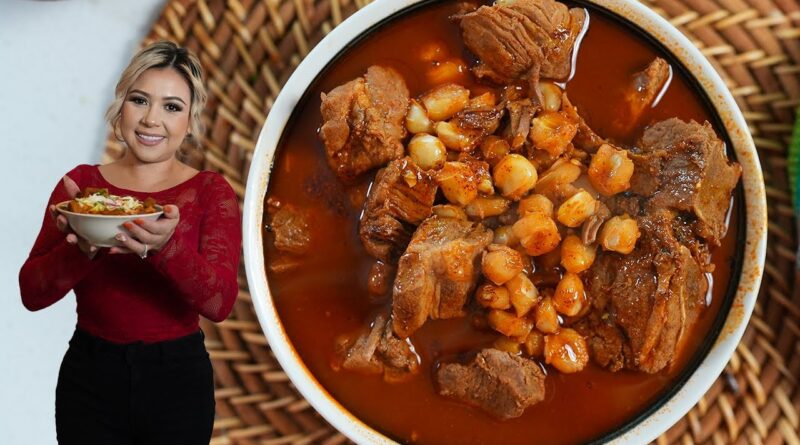Receta de pozole en inglés: cómo preparar este tradicional platillo mexicano paso a paso
How to Make Traditional Mexican Pozole: Step-by-Step Guide
If youve ever wondered how to prepare authentic Mexican pozole in English, youre in the right place. This beloved dish, rich in flavor and history, is a staple in Mexican cuisine and has gained popularity worldwide, including here in Peru. Known for its hearty broth, tender meat, and hominy kernels, pozole is perfect for family gatherings, celebrations, or simply to enjoy a comforting meal.
To understand the recipe for pozole in English, its important to know the core ingredients and the traditional preparation methods that make this dish so special. Pozole comes in several variations — mainly pozole blanco (white), pozole rojo (red), and pozole verde (green) — each with unique flavors and regional touches.
The base of all types is hominy (nixtamalized corn kernels), which gives pozole its distinctive texture and flavor. The meat used is typically pork, but chicken or a combination can also be used depending on preference.
Understanding the Ingredients
Before diving into the preparation steps, lets review the essential components:
- Hominy (white corn kernels) – Usually canned or dried and soaked overnight.
- Pork meat – Commonly pork shoulder, sometimes with bones for more flavor.
- Chilies – Guajillo, ancho, or jalapeño chilies depending on the variety.
- Garlic and onions – For the broth base.
- Seasonings – Salt, pepper, oregano, and sometimes cumin.
- Garnishes – Shredded lettuce or cabbage, radishes, lime wedges, chopped onions, oregano, and tostadas or tortilla chips.
Now, lets explore how you can prepare this traditional Mexican dish at home, explained clearly in English, so you can share it with your friends or family who may not be familiar with Spanish culinary terms.
Step-by-Step Preparation of Classic Mexican Pozole
The process of making pozole is a rewarding experience that requires patience but guarantees a delicious result. The first step involves preparing the hominy. If you use dried hominy, it needs to be soaked overnight and then boiled until soft. Canned hominy is a convenient alternative and reduces cooking time.
Meanwhile, in a large pot, you will cook the pork meat. Start by rinsing the pork shoulder and cutting it into large chunks. Place the meat in the pot with enough water to cover it, add a quartered onion, a few garlic cloves, and a pinch of salt. Bring it to a boil, then reduce to a simmer and cook for approximately two hours or until the meat is tender and easy to shred.
While the meat cooks, prepare the chili sauce if youre making a red or green pozole variant. For red pozole, soak dried guajillo and ancho chilies in hot water for 15-20 minutes until soft. Then blend them with garlic, onion, and a bit of the soaking water until you get a smooth sauce. For green pozole, use fresh green chilies like jalapeños or serranos, blended with cilantro, tomatillos, garlic, and onion.
Once the pork is tender, remove it from the broth and shred it with two forks. Strain the broth to remove onion and garlic pieces, then return the broth to the pot. Add the hominy and the shredded pork back into the broth.
If youre preparing red or green pozole, add the chili sauce at this point. Stir well and let the soup simmer for an additional 30 minutes to allow the flavors to meld beautifully.
Tips for Serving and Garnishing
Pozole is traditionally served with a variety of fresh garnishes that add crunch, acidity, and brightness to the rich soup. Some of the most popular toppings include:
- Shredded lettuce or cabbage – Adds a fresh crunch.
- Sliced radishes – Provides a peppery bite.
- Chopped white onions – For sharpness.
- Fresh lime wedges – To squeeze over for acidity.
- Dried oregano – Sprinkled on top for aroma.
- Chili powder or hot sauce – For those who like it spicy.
- Tostadas or tortilla chips – To scoop the soup.
Encourage your guests to customize their bowls according to their taste preferences, which is part of the fun when enjoying this dish.
Why Pozole is a Must-Try Mexican Dish
Beyond its irresistible taste, pozole carries deep cultural significance in Mexico. It is traditionally served during celebrations such as Mexican Independence Day, Christmas, and family gatherings. Its hearty nature makes it ideal for sharing and connecting over a delicious meal.
For Peruvian food enthusiasts, incorporating this Mexican classic into your cooking repertoire adds diversity and excitement to your kitchen. The blend of textures and flavors — from the tender pork to the chewy hominy and spicy chilies — offers a unique culinary experience.
Additionally, pozole is a versatile dish. You can adapt it to your dietary preferences by using chicken instead of pork, making it vegetarian by substituting mushrooms or jackfruit, or adjusting the spice level to suit your palate.
Common Variations and Adaptations
While the traditional recipes remain popular, many cooks have developed their own twists on this dish. Here are some variations you might find interesting:
- Pozole Blanco: The simplest version without chili sauce, focusing on the natural flavors of pork and hominy.
- Pozole Rojo: Uses red chilies to give a rich, smoky flavor and vibrant color.
- Pozole Verde: Made with green chilies, tomatillos, and herbs for a fresh, tangy taste.
- Chicken Pozole: A lighter option using shredded chicken instead of pork.
- Vegetarian Pozole: Replacing meat with hearty vegetables and mushrooms to maintain texture.
These adaptations allow the dish to fit various occasions and dietary needs while preserving the essence of pozole.
How to Explain the Recipe in English to Non-Spanish Speakers
When sharing the method of making this traditional Mexican stew with English-speaking friends or family, clarity and simplicity are key. Use straightforward terms and avoid regional jargon that might confuse those unfamiliar with Mexican cuisine.
For example, instead of using the word «nixtamalized,» explain that hominy is «corn kernels that have been soaked and cooked in an alkaline solution, which gives them a soft texture and unique flavor.» When referring to chilies, specify whether they are dried or fresh and describe their flavor profiles (mild, smoky, spicy).
Break down the cooking process into clear stages: preparing the broth, cooking the meat, making the chili sauce, and assembling the soup. This structured approach helps non-Spanish speakers follow the recipe easily and feel confident recreating the dish.
Also, encourage them to try garnishing their pozole with fresh ingredients to enhance the taste and enjoy the full traditional experience.
Useful Vocabulary for Describing Pozole in English
Here are some key terms that can help when explaining or searching for pozole recipes in English:
- Hominy: Processed corn kernels used in pozole.
- Broth: The flavorful liquid base made from cooking meat and aromatics.
- Shredded pork or chicken: The tender meat pieces in the soup.
- Chili sauce: A blended mixture of chilies, garlic, and spices.
- Garnishes: Fresh toppings added before serving.
- Simmer: To cook gently below boiling point.
Bringing Mexican Pozole to Your Peruvian Table
As Peruvians, we appreciate dishes that combine bold flavors with comforting textures, and this is exactly what pozole offers. Integrating this Mexican classic into your cooking not only expands your gastronomic horizons but also provides an opportunity to connect with another rich culinary tradition.
You can find most ingredients in local markets or specialized stores, especially canned hominy and dried chilies. Pork shoulder is widely available, and fresh garnishes like radishes and cabbage are staples in Peruvian cuisine, making this dish easy to prepare with local products.
Cooking pozole can also be a communal activity. Invite family members to help with chopping garnishes or preparing the chili sauce, turning the process into a festive event reminiscent of the Mexican celebrations where this dish shines.
Whether you choose the white, red, or green version, the end result will be a delicious, hearty meal that warms the soul and pleases the palate. This fusion of Mexican tradition with Peruvian hospitality makes for a memorable dining experience.
Final Tips for Perfecting Your Pozole
To ensure your pozole turns out perfect every time, keep these recommendations in mind:
- Use quality hominy: The texture of the corn kernels is crucial for the soup’s character.
- Simmer slowly: Allow the flavors to develop fully by cooking the broth gently over time.
- Adjust seasoning gradually: Taste the soup as it cooks to balance salt and spice levels.
- Prepare garnishes fresh: They provide the contrast that makes each bite exciting.
- Serve hot: Pozole is best enjoyed steaming and fresh.
With these steps and tips, you are well-equipped to make an authentic and delicious Mexican pozole at home, even explaining the process in English for your friends or guests. Embrace the tradition, enjoy the flavors, and share the joy of this iconic dish.

